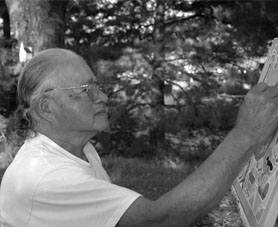Home | Programs | Individual Creativity | Ohio Heritage Fellowships | 2011 Heritage Fellowships
2011 Ohio Heritage Fellowship Recipient
Performing Arts
 Kanniks Kannikeswaran is a visionary composer and music educator and scholar whose work has been performed in and has had an impact in several parts of the world. Cincinnati based musician Kanniks is a prolific composer and his compositions include a wide range of genres such as oratorios, kritis, tillanas, dhrupads, musical theater productions and more.
Kanniks Kannikeswaran is a visionary composer and music educator and scholar whose work has been performed in and has had an impact in several parts of the world. Cincinnati based musician Kanniks is a prolific composer and his compositions include a wide range of genres such as oratorios, kritis, tillanas, dhrupads, musical theater productions and more.
Kanniks is the pioneer of the Indian American choral movement. His far reaching work in this area has led to the founding of Indian community choirs in several places such as Allentown PA, Tampa FL, Houston TX, Minneapolis MN and more. Kanniks has singlehandedly traveled to these places and built musical productions channeling the local energy, resulting in local community choirs and long lasting collaborations. His magnum opus ‘Shanti – A Journey of Peace’ has been performed with a huge cast in Cincinnati OH, Allentown PA and Houston TX even as other communities are gearing towards future performances. Shanti has touched, moved and inspired over 900 performers in 5 seasons and has been seen by over 9000.
Kanniks has collaborated with artists such as Lakshmi Shankar, Mallika Sarabhai, with the Cincinnati Chamber Orchestra to name a few and his work has been performed by large ensembles at the National University of Singapore. He has been teaching at the University of Cincinnati in the capacity of an Adjunct Faculty since 1994, and regularly presents his scholarly work at the Madras Music Academy and other venues during the music season.His award winning research on the 18th century Indo Colonial music of India is beginning to have an impact on Indian musical pedagogy. Kanniks is a recipient of various awards such as the prestigious McKnight Fellowship (Visiting Composer Residency – Minnesota), the Ohio Heritage Fellowship from the State of Ohio, and the Just Community Award from the University of Cincinnati. He is often described as a renaissance personality who effortlessly traverses diverse disciplines such as music, spirituality and management. His work is much sought after worldwide and he has delivered lectures on Indian music and culture in Singapore, Trinidad, and in several cities in the United States.
Kanniks is on the music advisory committee of the ‘World Choir Games’ 2012 to be held in Cincinnati OH. He is the founder of the ‘American School of Indian Art’, an Institution committed to bringing the best of the East and the West to the Indian American diaspora and beyond.
Material Culture

Edwin George, a member of the Eastern Band of Cherokees, was born in 1934 and raised in a mountain-side log cabin in Cherokee, NC. He grew up with limited educational opportunities, but in a home rich with native culture, stories, myths, and traditions. As a youth he and his family spoke only the Cherokee language. Though Edwin’s parents had minimal education and worked labor-type jobs, both taught him to honor the stories and legends of the Cherokee people. His mother’s sister, Martha Owl, was a master basket weaver, and Edwin remembers watching her dedication to her craft. Edwin left the reservation to find better employment opportunities, and eventually learned to speak some English.
His marriage and life experience brought him to Ohio, where he worked for over 20 years as a custodian at Ohio State and Kent State Universities. During this time, he began to work with wood, whittling, carving, and painting totem poles, hiking sticks, and small sculptures. He once built a totem pole so large and detailed that he wasn’t able to get it out of his small home after assembling it. His passion to make art intensified.
In 1991, Edwin began to paint. His very first painting was the cabin of his youth, perched upon a tree covered mountainside. He labored over it, hesitantly trying to paint a realistic looking cabin. After that first attempt, a flood of Cherokee images, stories, myths, colors, animals and foliage flowed into his mind, and he realized that after all of this time, he needed to share his knowledge of the Cherokee language, culture, and mythology.
He had always been tentative about sharing his culture because of his limited English-speaking abilities, but found that, through his paintings, he could share and express an abundance of his history without being hindered by his limited language skills.
[top]